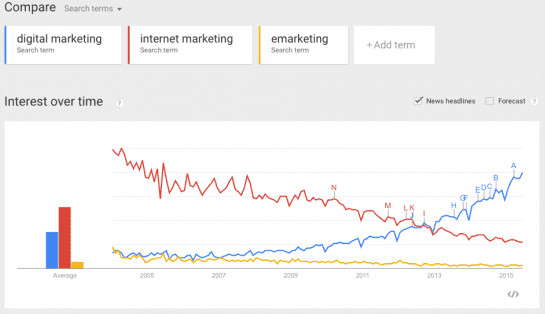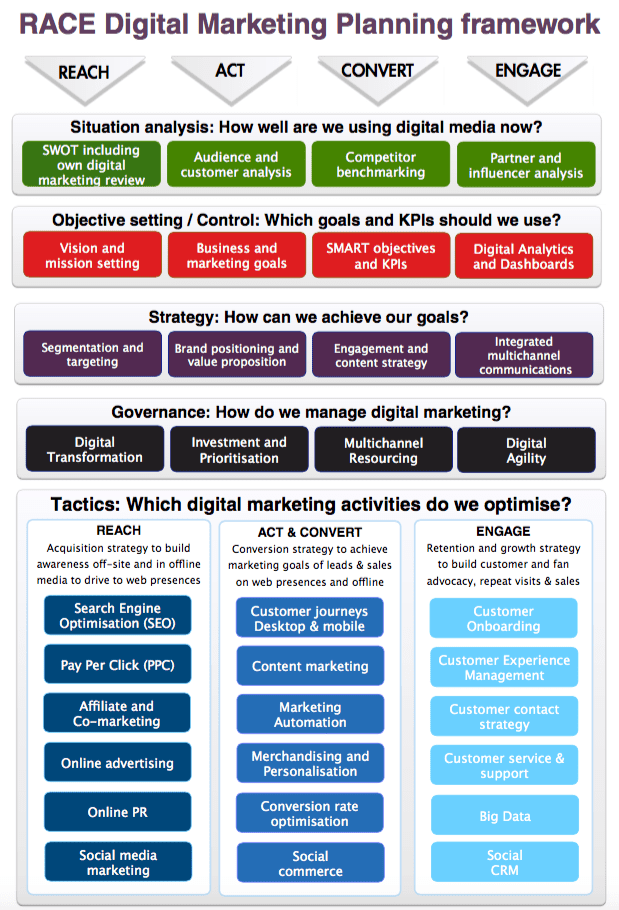Defining the scope of digital marketing using the '5Ds of Digital' and the Smart Insights RACE planning framework.
Dave Chaffey’s recent blog post on digital marketing trends shows the latest innovations, but here we go back to basics to define digital marketing. This is important since for some in business, particularly more traditional marketers or business owners, 'digital' is simplistically taken to mean 'our website' or 'our Facebook page'. This thinking limits the scope and opportunity of what's managed and it means that activities that should be managed may be missed.
This isn't just semantics important since for some in business, particularly more traditional marketers or small business owners, 'digital' is simplistically taken to mean 'our website' or 'our Facebook page'. This thinking limits the scope and opportunity of what's possible and what needs to be managed and it means that activities that should be managed may be missed.
The 5Ds of digital marketing
To understand the importance of digital marketing to the future of marketing in any business, it’s helpful to think about what audience interactions we need to understand and manage. Digital marketing today is about many more types of audience interaction than website or eemail, it involves harnessing these ‘5Ds of Digital’ that I have defined in the introduction to the latest update to my Digital Marketing: Strategy, Planning and Implementation book. The 5Ds we need to assess consumer adoption for and how our business can priotizse their use are:
- 1. Digital devices – our audiences interact with businesses using smartphones, tablets, desktop computers, TVs and gaming devices
- 2. Digital platforms – most interactions on these devices are through a browser or apps from the major platforms or services, that’s Facebook (and Instagram), Google (and YouTube), Twitter and LinkedIn •
- 3. Digital media – different paid, owned and earned communications channels for reaching and engaging audiences including advertising, email and messaging, search engines and social networks
- 4. Digital data – the insight businesses collect about their audience profiles and their interactions with businesses which now needs to be protected by law in most countries
- 5. Digital technology – the marketing technology or martech stack that businesses use to create interactive experiences from websites and mobile apps to in-store kiosks and email campaigns
Defining digital marketing
The use of the Internet and other digital media and technology to support ‘modern marketing’ has given rise to a bewildering range of labels and jargon created by both academics and professionals. It has been called digital marketing, Internet marketing, e-marketing and web marketing and these alternative terms have varied through time...
Digital Marketing is the term most frequently used today, as we can see from these digital marketing definitions , so that is the term we focus on.
Because of the recent debate about the use of the term ‘digital marketing’, we thought it would be useful to pin down exactly what digital means through a definition. Do definitions matter? We think they do, since particularly within an organisation or between a business and it's clients we need clarity to support the goals and activities that support Digital Transformation. As we'll see, many of the other definitions are misleading.
Boiled down to its simplest form, digital marketing is defined in Dave Chaffey's book Digital Marketing: Strategy, Implementation and Practice as simply:
Achieving marketing objectives through applying digital technologies and media.
I expand on this definition of digital marketing to explain that, in practice, digital marketing includes managing different forms of online company presence and presences such as company websites, mobile apps and social media company pages. This is in conjunction with online communications techniques including the likes of search engine marketing, social media marketing, online advertising, e-mail marketing and partnership arrangements with other websites. These techniques are used to support the objectives of acquiring new customers and providing services to existing customers that help develop the customer relationship through E-CRM and marketing automation. However, for digital marketing to be successful, there is still a necessity for integration of these techniques with traditional media such as print, TV and direct mail as part of multichannel marketing communications.
If we look at these other definitions of digital marketing such as this definition of digital marketing from SAS: What is Digital Marketing and Why does it matter? or this alternative definition of digital marketing from Wikipedia we can see that often there is a focus on promoting of products and services using digital media rather than a more holistic definition covering customer experiences, relationship development and stressing the importance of multichannel integration. So for us, the scope of the term should include activities across the customer lifecycle:
- Digital media and communications channels
- Digital and mobile experiences such as web design and mobile apps
- Prospect and customer relationship management through marketing automation
- Digital strategy and integrating multichannel communications and experiences
- Digital technologies and platforms to manage all digital marketing activities
The role of digital platforms in supporting integrated multichannel marketing is an important component part of digital marketing, yet is often overlooked. In many ways, this highlights how important it is to break down silos between ‘digital’ and ‘traditional’ marketing departments. Online channels can also be managed to support the whole buying process from pre-sale to sale to post-sale and further development of customer relationships.
Defining marketing
It is important to remember that just because digital marketing uses different communications techniques to traditional marketing, its end objectives are no different from the objectives that marketing has always had. It can be easy to set objectives for digital marketing based around ‘vanity metrics’ such as number of ‘likes’ or followers, so it is useful to bear in mind this definition of marketing advanced by the Chartered Institute of Marketing:
"Marketing is the management process responsible for identifying, anticipating and satisfying customer requirements profitably".
This definition emphasizes the focus of marketing on the customer while at the same time implying a need to link to other business operations to achieve this profitability. Yet, it's a weak definition in relation to digital marketing since it doesn't emphasize communications which are so important to digital marketing. In Digital Marketing Excellence my co-author, PR Smith and I note that digital marketing can be used to support these aims as follows:
- Identifying – the Internet can be used for marketing research to find out customers’ needs and wants
- Anticipating – the Internet provides an additional channel by which customers can access information and make purchases – evaluating this demand is key to governing resource allocation.
- Satisfying – a key success factor in digital marketing is achieving customer satisfaction through the digital channel, which raises issues such as: is the site easy to use, does it perform adequately, what is the standard of associated customer service and how are physical products dispatched?
Optimising digital marketing can be tricky, and a simple definition does not necessarily translate into something that is useful for achieving business objectives. That is where the RACE Digital Marketing Planning framework comes in, as it can help break down digital marketing into easier to manage areas which can then be planned, managed and optimised.
Our graphical summary definition of the scope of digital marketing
To answer the question 'What is digital marketing?', we have put together this new visual definition summarising all the activities that form digital marketing that need to be managed across the Smart Insights RACE Planning framework. It's used in the new, 6th edition of Dave's Digital Marketing book. We explain best practices for all of these in our Digital Marketing Elearning course. The infographic is divided into activities to develop and manage digital strategy at the top to the marketing activities at the bottom.
Conclusion
So, digital marketing is about utilising digital technology to achieve marketing objectives. There is no essential need for digital marketing to always be separate from the marketing department as a whole, as the objectives of both are the same. However, for now, it remains a useful term because digital marketing requires a certain skill set to utilise the digital technology effectively. As our recent Developing Digital Skills report showed, many marketers are now spending > 50% of their time on digital marketing activities and two of the three top job roles in marketing are digital, so clearly digital skills are needed.
source http://www.smartinsights.com/digital-marketing-strategy/what-is-digital-marketing/


No comments:
Post a Comment